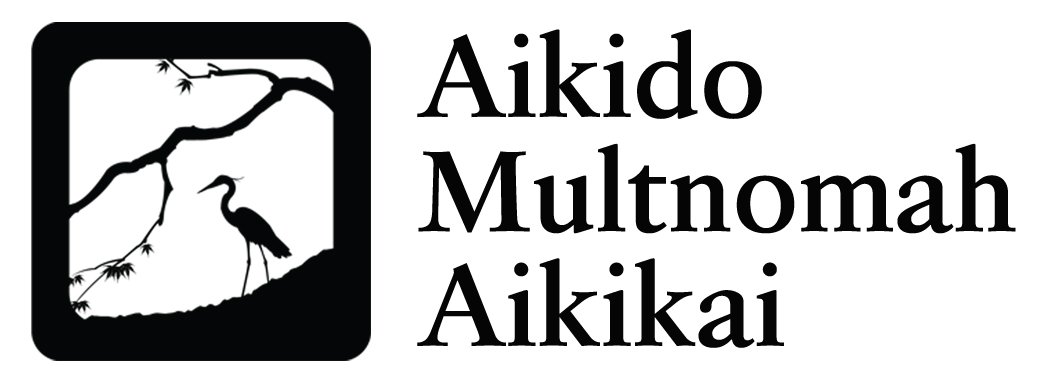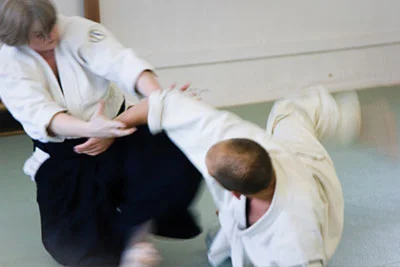The Practice of Aikido
Centered, connected, whole, lively, and open
As we practice, we strive to embody these qualities and cultivate our “aikido body.”
T.K. Chiba Shihan expounded the five pillars and the cultivation of an “aikido body.” Visual concept of the compass by Suzane Van Amburgh. Artwork by Thea Oatman.
Self- transformation is an outcome of this unique educational system.
Through regular aikido practice we improve balance, learn to manage oneself under pressure, identify options in tight situations, find greater comfort in uncomfortable moments, recognize the impact we have on others, mature as a person, and cultivate “a life well lived.”
~~~
Get started with Aikido
Prospective students: At this time we are accepting new aikido students.
Please observe at least one class before joining. Contact us to schedule a dojo visit.
Learn how we’re addressing the pandemic in our dojo. Read our dojo COVID protocols and updates.
Adult (aged 18 or over): If you are ready to get started now, please register for Regular Membership.
Teens usually do well in the adult program. We have a special rate for teens aged 13-17. Register for Teen Membership
Note: In addition to in-person classes, members are also granted access to online learning resources through our Dojo Online. Throughout the pandemic we have continually adapted our class formats and updated our new student policies. Depending upon the public health environment we may shift the proportion of class formats. We offer a mix of classes held in-person inside the dojo, outdoors, and virtually.
Are you a parent interested in enrolling your child (7-12) in the Children’s Aikido program? Contact us and schedule a dojo visit.
Returning and transfer students: If you are a returning dojo member or student transferring from another dojo, you are encouraged to contact Van Amburgh Sensei and book a phone appointment. If you are here in town, you may schedule a dojo visit. We look forward to welcoming you!
“I will never forget what I’ve learned from Dave Dewberry Sensei, Suzane Van Amburgh Sensei, Aki Fleshler Sensei, and all the amazing students and instructors at Multnomah Aikikai. I highly encourage anyone at any stage of life to study at Multnomah Aikikai. We will all fall down from time to time, knowing how to roll with it and stand up again is one of the greatest gifts I was given there.”
The Art and Tradition of Aikido
History, martial logic, philosophy…
Aikido is a modern, non-violent, non-aggressive Japanese martial art, developed early in the twentieth century by Morihei Ueshiba (1883-1969). “Aiki” means “blending body with mind to the movements of energy.” “Do” means “a way or path chosen towards self-realization.” As a system of self-defense it employs techniques based upon circular motions that first blend with the attack and energy of your opponent, then imbalance the opponent, leading to a throw or pin.
The movements of aikido are generally smooth and fluid. Circles and spirals predominate in the techniques. In the rhythm of practice, partners change roles allowing each to feel both aspects (attack and defense) of the technique. The general atmosphere of training is one of mutual cooperation and respect. Aikido is a way of coordinating both body and mind through the training and discipline of learning technique, thereby energizing the body and increasing awareness.
Aikido is primarily practiced as an empty-handed art (tai-jutsu, meaning “body arts”). We study a variety of responses to grabbing or striking attacks. Rather than meeting the force of an attack head on, the defender moves his or her body out of range, taking the attacker’s balance and culminating the technique in either a throw or hold-down. As a student progresses, he/she studies the principles of Aikido through the use of the bokken (wooden sword), jo (wooden staff), and tanto (wooden knife). Weapons work reveals the importance of proper distance, timing, and precision of body movement. It also develops a student’s breathing and concentration.
Aikido physical training is characterized by the repetitive practice of various motions known as kata (forms), until rational and unforced movement flows naturally throughout the body. This training includes empty-hand techniques along with sword, staff, and knife defenses. The intensity and focus of martial training is used as a “Way” to increase mindfulness and self-awareness, as well as to unify the mind and body.
The fact that there are no competitions in Aikido is a logical conclusion of its philosophy. Since winning and losing are never a concern, practitioners are free to dedicate their efforts to mutual goals. It is therefore possible for men, women, and children of all ages to walk together down the path of budo, the heart of Aikido.
Read an article by D. Bluhm Sensei about Cultivating the Aikido Body and learn more about the pillars: Centered, Connected, Whole, Lively, and Open.
Aikido Weapons Practice
Study distance, timing, and precision of body movement practicing aikido with the wooden bokken and jo.
Bokken, Tanto, and Jo: Wooden training Weapons
Aikido is primarily known for and practiced as an empty-handed art (tai-jutsu, meaning “body arts”). However, as a student progresses, he/she studies the principles of Aikido through the use of the bokken (wooden sword), jo (wooden staff), and tanto (wooden knife).
Weapons work reveals the importance of proper distance, timing, and precision of body movement. It also develops a student’s breathing and concentration. Techniques for responding to multiple assailants and weapons take-away are also studied.
What distinguishes Aikido from Jiu-Jitsu and other arts is it's integration of body arts (unarmed) and weapons techniques. Posture, movement, and awareness for both attacker and defender are virtually identical whether or not an actual weapon is present.
T. K. Chiba Sensei and our Birankai community of practice are particularly known for this integration of weapons work and body arts.
I think that instead of analyzing and comparing how each technique or movement is related to weapons work, it makes much more sense to me to see and feel the sameness in executing one’s energy by which aikido is distinguished from other martial arts. …the writer Tenryu, a famous Sumo wrestler who once challenged O-Sensei, was defeated, and became O-Sensei’s uchideshi thereafter, describes aikido by saying that it is a martial art which is the ultimate transformation of swordsmanship into a body art. I personally agree with his statement, and have been deeply inspired by this. However, it no longer matters to me nowadays to say which comes first, body arts or weapons. I see no difference.
– T.K. Chiba, April, 1994
For those who wish to deepen their study, training is also offered in Iaido (the art of traditional Japanese sword drawing).
Begin your journey
“After just seven classes I must say I am finding this experience to be really valuable. I usually quit stuff I am not good at, and being able to hang in there and kind of enjoy myself is a great pattern breaker for me. At this phase of my training, just showing up and being as present as possible, having patience with myself for not being able to translate instructions into behavior, and not having that mean something negative about me, is great progress. All three Sensei’s and all of the senior students have been incredibly, kind and patient. For this I am really grateful.”
“My experience has been great. I didn’t know what to expect but I’m really having fun. All the instructors and students strike the perfect balance of being kind but firm. They want me to learn the techniques the right way so I don’t get injured, but they deliver the instruction with a smile. Only 2 months in I notice I’m gaining confidence and calm in other aspects of my life. I have a little more spring in my step, I’m actually getting better at basketball, and I can’t wait to learn more!”




